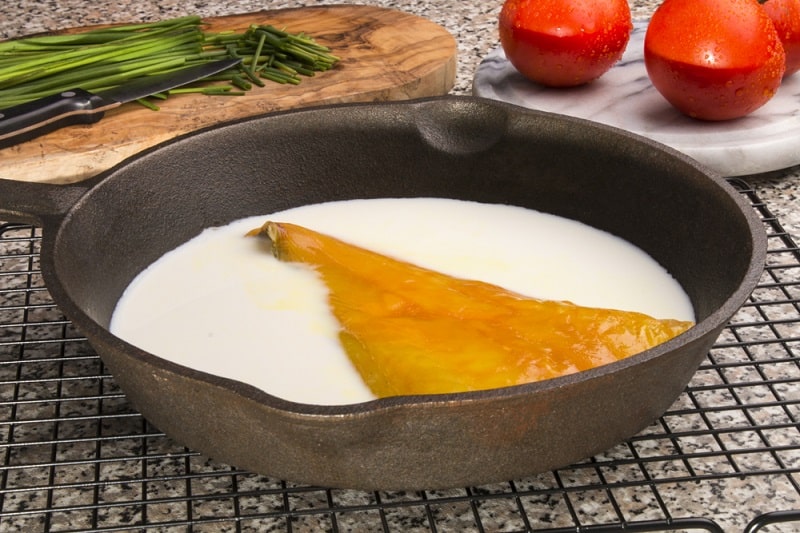Poaching is a great way to enjoy a piece of fish, ensuring that it’s soft and full of flavour. Many different liquids can be used for poaching including wine or oil, but some chefs believe there’s none better than milk.
Poaching your fish in milk creates a creamy flavour that’s almost like chowder.
If you combine it with herbs, you’ll infuse your fish with an intense herby flavour that you didn’t even realise was possible! This is due to the high fat content of the milk, and why whole milk is preferable to skimmed.
Whatever aromatics you throw in the pan will be sucked up eagerly by the milk and transferred to your fish without losing any of the flavour.
But once you’ve removed your fish, what should you do with the remaining milky liquid? Of course, you could easily throw it away, but it is a huge waste of a very tasty liquid.
Below you’ll find some ideas that top chefs recommend when left with milk after poaching fish.
Ways to Use the Milk from Poached Fish
Once you’ve removed your fish from the poaching liquid, there’s no need to throw it away.
Depending on what you’ve added for flavour, the milk could be a very aromatic liquid that could be used to great effect in other dishes.
What you choose to use the poaching milk for will depend on what flavours are in the liquid.
Some options could include using it for mashed potato, as a base sauce for a fish pie or you could make a full chowder from the liquid if you add in diced potatoes, peas, fish and maybe some bacon.
If you don’t like the idea of keeping the milk to use in another dish, you could thicken with cornflour and add a splash of lemon juice and parsley and serve over the fish.

Is it Safe to Cook Fish in Milk?
Yes, poaching fish in milk is a technique that chefs from all around the world have been using for a very long time.
It provides a much richer and creamier flavour than other types of poaching and is a quick and convenient way to cook fish.
Some types of fish are more prone to falling apart while being poached so look for firm white fish such as cod, halibut, or tuna.
Keep the skin on before cooking as that helps the fish fillet to hold together; it’s easy enough to remove on the plate after it’s finished poaching.
Poaching fish in milk offers lots of nutritional and gastronomic benefits, but there are practical reasons too.
Not everyone likes the odour from cooking fish, especially more pungent fish such as smoked haddock.
Poaching fish in milk helps to minimise the smell of the fish while cooking. The milk catches and traps the smell more effectively, thus reducing the odour in the air.
Should You Defrost Fish in Milk?
Although milk is excellent for poaching fish, it also has some interesting other uses including helping to defrost frozen fish.
Seafood should always be defrosted in the fridge overnight to prevent any bacteria from forming, which is a risk when fish is at room temperature.
Placing the fish in milk to defrost protects it during the thawing process. The milk draws out the “frozen” flavour and leaves the fish tastes much fresher on your plate.
Unlike poaching fish in milk, the milk used for defrosting fish isn’t suitable for re-using. Containing ice crystals and a strong fishy taste, it’s not a pleasant liquid and is best simply poured away.

Chef’s Pick is your guide to the best kitchen equipment and appliances in the UK.
We help you understand the confusing world of cookers, ovens and cookware so you can get the most out of your kitchen.

